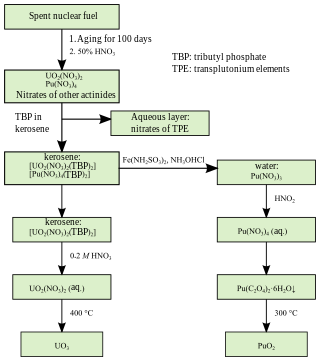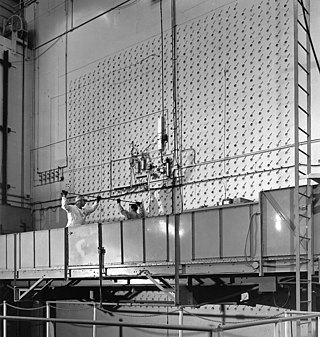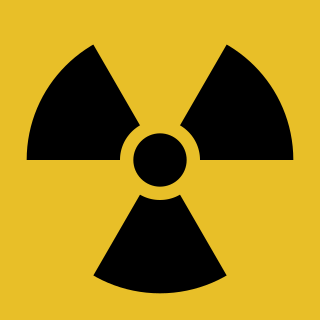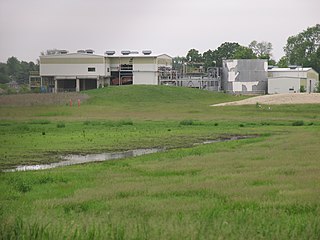
Radioactive waste is a type of hazardous waste that contains radioactive material. Radioactive waste is a result of many activities, including nuclear medicine, nuclear research, nuclear power generation, nuclear decommissioning, rare-earth mining, and nuclear weapons reprocessing. The storage and disposal of radioactive waste is regulated by government agencies in order to protect human health and the environment.
Crescent is a city in Logan County, Oklahoma, United States. The population was 1,299 as of the 2020 United States census. It is part of the Oklahoma City Metropolitan Statistical Area.

The Baghdad Nuclear Research Facility adjacent to the Tuwaitha "Yellow Cake Factory" or Tuwaitha Nuclear Research Center contains the remains of nuclear reactors bombed by Iran in 1980, Israel in 1981, and the United States in 1991. It was used as a storage facility for spent reactor fuel and industrial and medical wastes. The radioactive material would not be useful for a fission bomb, but could be used in a dirty bomb. Following the 2003 invasion of Iraq, the facility was heavily looted by hundreds of Iraqis, though it is unclear what was taken.

Silkwood is a 1983 American biographical drama film directed by Mike Nichols, and starring Meryl Streep, Kurt Russell, and Cher. The screenplay by Nora Ephron and Alice Arlen was adapted from the book Who Killed Karen Silkwood? by Rolling Stone writer and activist Howard Kohn, which detailed the life of Karen Silkwood, a nuclear whistle-blower and a labor union activist who investigated alleged wrongdoing at the Kerr-McGee plutonium plant where she worked. In real life, her inconclusive death in a car crash gave rise to a 1979 lawsuit, Silkwood v. Kerr-McGee, led by attorney Gerry Spence. The jury rendered its verdict of $10 million in damages to be paid to the Silkwood estate, the largest amount in damages ever awarded for that kind of case at the time. The Silkwood estate eventually settled for $1.3 million.

A nuclear and radiation accident is defined by the International Atomic Energy Agency (IAEA) as "an event that has led to significant consequences to people, the environment or the facility." Examples include lethal effects to individuals, large radioactivity release to the environment, or a reactor core melt. The prime example of a "major nuclear accident" is one in which a reactor core is damaged and significant amounts of radioactive isotopes are released, such as in the Chernobyl disaster in 1986 and Fukushima nuclear disaster in 2011.

The Kerr-McGee Corporation, founded in 1929, was an American energy company involved in oil exploration, production of crude oil, natural gas, perchlorate and uranium mining and milling in various countries. On June 23, 2006, Anadarko Petroleum acquired Kerr-McGee in an all-cash transaction totalling $16.5 billion plus $2.6 billion in debt and all operations moved from their base in Oklahoma, United States. As a result of further acquisitions, most of the former Kerr-McGee is now part of Occidental Petroleum.

Karen Gay Silkwood was an American chemical technician and labor union activist known for reporting concerns about corporate practices related to health and safety in a nuclear facility.

The Savannah River Site (SRS) is a U.S. Department of Energy (DOE) reservation in the United States, located in the state of South Carolina on land in Aiken, Allendale, and Barnwell counties adjacent to the Savannah River. It lies 25 miles (40 km) southeast of Augusta, Georgia. The site was built during the 1950s to refine nuclear materials for deployment in nuclear weapons. It covers 310 square miles (800 km2) and employs more than 10,000 people.

PUREX is a chemical method used to purify fuel for nuclear reactors or nuclear weapons. PUREX is the de facto standard aqueous nuclear reprocessing method for the recovery of uranium and plutonium from used nuclear fuel. It is based on liquid–liquid extraction ion-exchange.

The La Hague site is a nuclear fuel reprocessing plant at La Hague on the Cotentin Peninsula in northern France, with the Manche storage centre bordering on it. Operated by Orano, formerly AREVA, and prior to that COGEMA, La Hague has nearly half of the world's light water reactor spent nuclear fuel reprocessing capacity. It has been in operation since 1976, and has a capacity of about 1,700 tonnes per year. It extracts plutonium which is then recycled into MOX fuel at the Marcoule site.

Anadarko Petroleum Corporation was a company engaged in hydrocarbon exploration. It was organized in Delaware and headquartered in two skyscrapers in The Woodlands, Texas: the Allison Tower and the Hackett Tower, both named after former CEOs of the company. In 2019, the company was acquired by Occidental Petroleum.
Tronox Limited is an American worldwide chemical company involved in the titanium products industry with approximately 6,500 employees. Following its acquisition of the mineral sands business formerly belonging to South Africa's Exxaro Resources, Tronox is the largest fully integrated seller and marketer of titanium dioxide (TiO2) pigment, which provides brightness to applications such as coatings, plastics and paper. Tronox also sells titanium ore – the main feedstock of titanium dioxide - and zircon directly to customers.

The X-10 Graphite Reactor is a decommissioned nuclear reactor at Oak Ridge National Laboratory in Oak Ridge, Tennessee. Formerly known as the Clinton Pile and X-10 Pile, it was the world's second artificial nuclear reactor and the first designed and built for continuous operation. It was built during World War II as part of the Manhattan Project.

Since the mid-20th century, plutonium in the environment has been primarily produced by human activity. The first plants to produce plutonium for use in Cold War atomic bombs were the Hanford nuclear site, in Washington, and Mayak nuclear plant, in Chelyabinsk Oblast, Russia. Over a period of four decades, "both released more than 200 million curies of radioactive isotopes into the surrounding environment – twice the amount expelled in the Chernobyl disaster in each instance."

This is a list of criminal acts intentionally involving radioactive substances. Inclusion in this list does not necessarily imply that anyone involved was guilty of a crime. For accidents or crimes that involved radioactive substances unbeknownst to those involved, see the Nuclear and radiation accidents and incidents.
Sequoyah Fuels Corporation owned and operated a uranium processing plant near Gore, Oklahoma. The company was created in 1983 as a subsidiary of Kerr-McGee. In 1988 it was sold to General Atomics.
The Plutonium Finishing Plant (PFP), also known as 'Z Plant', was part of the Hanford Site nuclear research complex in Washington, US.

The Rare Earths Facility was a production plant for various chemicals and metals including thorium, uranium, and radium. It was located in West Chicago, Illinois, USA.

Ambrosia Lake is a uranium mining district in McKinley and Cibola counties in New Mexico north of Grants that was heavily mined for uranium starting in the 1950s. It is in an anticlinal dome.

Nuclear labor issues exist within the international nuclear power industry and the nuclear weapons production sector worldwide, impacting upon the lives and health of laborers, itinerant workers and their families.